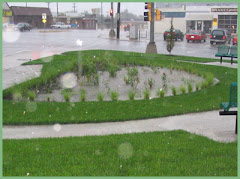Over 4000 years ago, rainwater harvesting technology was used by the Ancient Romans. Over time wells became more popular and in the process, rainwater harvesting lost appeal. Today, rainwater harvesting has been rejuvenated becoming one of the driving forces in green technology for buildings. This technology has grown in popularity throughout the world, especially in Australia its dry climate and limited access to water supply making water conservation a necessity. This report will evaluate what methods of rainwater harvesting can be applied to residential sites in Kamloops.
Kamloops experiences an average of only 270mm of precipitation per year (snow and rain combined). Kamloops is located in BC’s interior and east of the coastal mountain range; because of its geographical location near the mountains this produces a rain shadow effect where very little precipitation will fall in the city. This poses a problem especially in the summer months; there are often water restrictions because of low water reservoir concerns in Kamloops. In the fall or winter, heavy rainfall generally discharges through the stormwater drain system directly into rivers or streams, potentially carrying contaminants, increasing sediment levels, scouring banks and destroying habitat in the process. Through stormwater retention techniques and harvesting rainfall for future uses reduces the volumes produced by individual residences, easing the stress on stormwater services, as well as providing water for some domestic uses. About 40% of water usage in the summer is used for irrigating lawns and gardens, all, or most of which can be replaced by rainwater. This also reduces the volumes of treated potable water being used unnecessarily for irrigation. In heavy precipitation months, retaining water on site is very important to relieve volumes in storm sewers. The use of rain gardens or bioswales allows rainwater to infiltrate back into the ground as part of the rainwater cycle, in the process irrigating these gardens. A main point that must be addressed in order for Leadership in Energy and Environmental Design (LEED) certification points is the control of storm water and how it is treated on-site.
There are two methods of rainwater harvesting that will be examined; rain barrels (cisterns) and/or storage tanks, and rain gardens. Residential rain barrels are usually 60 or 90 gallon barrels that store the rain intercepted on the roof, conveyed to the gutters, and then transferred to the downspout where the pipe is directed into the barrel. The barrel supports a hose bib connection so gardens can be watered. Rain gardens are intentionally depressed areas that allow rainwater to collect, allowing infiltration and irrigation to the landscape. Storage tanks allow retention of water and recycling the water back into the house for non-potable usage. Submersible pumps in these tanks allow water supply to toilets, washing machines, dishwashers, and irrigation systems, which do not require potable water.
The technology of retaining rainwater and reusing it in the home is a great environmental initiative that should be implemented in homes that have difficulty controlling storm water, where there are a high percentage of impervious surfaces on the lot, or homes and yards that have restrictive water supplies. The Canadian government should encourage and reward developers and home owners that implement a rain capture and recycling system. This reports main focal point is to educate the construction industry on the value of onsite stormwater management, and methods available to control and retain stormwater for the benefit of the homeowners, local infrastructure (domestic water delivery and stormwater services), and the environment.







